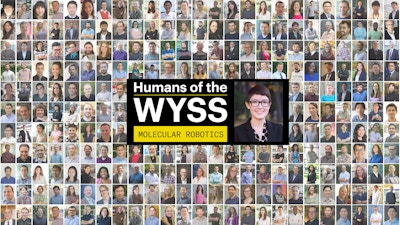
The Humans of the Wyss series features members of the Wyss community discussing how they think about their work, the influences that help shape them as scientists, and their collaborations at the Wyss Institute and beyond.
In this installment of our Molecular Robotics Edition, we talk to graduate student Josie Kishi about her work developing Primer Exchange Reactions (PERs) and how she envisions her research impacting the world.
What drives you?
I studied computer science in college, and when I first learned about DNA computing and molecular robotics, I was just so amazed at how it was possible to control and manipulate information on such a small scale. It’s been amazing getting to work with so many talented people here at the Wyss, with backgrounds in every science field you could think of, and there’s this real push to make technologies that can translate into real-world applications that motivates many of us.
You’re working on Primer Exchange Reactions (PERs), tell us more.
We recently came out with a paper about PERs, which programmably synthesize single-stranded sequences with a simple mixture of DNA primers, DNA hairpins, and a polymerase. Now, I am working on several compelling follow up applications using these reactions. Perhaps the most exciting is our effort to implement molecular recorders that can record information about a molecular environment over time.
In the long term, I envision molecular robotics disrupting other fields such as long-term data storage, with our unprecedented control at the nanoscopic scale.
Share with us some of the challenges you’re facing.
One of the projects I work with involves visualizing these Primer Exchange Reaction (PER) synthesis reactions inside fixed cells and tissues. This is a totally different environment from a test tube, so learning first how to make these reactions work and also how to debug things when they go wrong has been challenging. We are unable to “see” what is happening at such a tiny length scale, so we have to find other ways to try to understand and visualize what went wrong.
So, how do you envision Molecular Robotics impacting the world?
DNA already stores incredible amounts of information, but now we are able to design it to also manipulate information. This lets us control molecular behaviors in a predictable, programmable way using our molecular robotic systems. In the short term, I think we are already seeing the potential of molecular robotics with new technologies for diagnosing diseases. In the long term, I envision molecular robotics disrupting other fields such as long-term data storage, with our unprecedented control at the nanoscopic scale.
